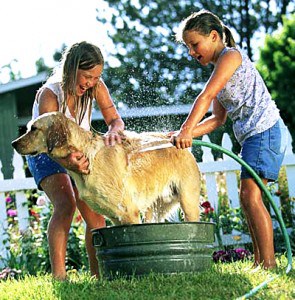No matter how clean and neat your pooch is, at some point in time they are going to need a bath.
Starting your puppy off understanding what a bath is will help deal with the issue when the dog gets older.
Labradors can be bathed indoors in a sink or bathtub, but larger breeds may need specialized equipment or an outdoor bath.
Some dogs will take to water and bathing more than others. Check with your breeder to find out if your Labrador is water-loving dog or not.
There are some commercially available “dry bath” powders that work well for quick deodorizing and freshening of the dog’s coat.
Care needs to be taken when using these powders to avoid contact with the eyes, mouth and ears.
Some dogs may be sensitive to the chemicals or perfumes in some soaps, shampoos or powders, so check a small area of your dog before treating the whole dog.
In order to bath your Labrador, follow these few simple steps.
- Clean all foreign matter out of the dog’s coat as much as possible. With a longhaired breed this may take a bit of time. Small twigs or other objects in the coat can cause tangling in the bath, so removing them ahead of time will save effort in the long run.
- Fill a sink, bathtub or other water container with luke-warm water and place the dog in the water. The water should not be deeper than the top of the animal’s legs or the bottom of its belly.
- Use your hands and arms to support the dog until it is comfortable and is not struggling. It is important to avoid any falls or slips at this time. Keep one hand gently placed on the back of the dog’s neck, or under the stomach for small breeds such as the Labrador. Keep praising and talking to the dog in a reassuring manner. Praise the dog for standing still.
- If you have a shower nozzle and hose, this is an ideal way to wet the dog down and rinse off the shampoo. Make sure that the water is warm to the touch, but not hot or cold before applying the water to the dog. Use only the gentlest setting if there is more than one way to adjust the water output from the nozzle.
- Begin slowly pouring water from a plastic pitcher or other plastic container onto the back of the dog, starting at the tail and moving towards the neck. It is important to avoid using glass objects in case of breakage. If the dog becomes nervous and tries to move, stop and calm the animal before proceeding. Do not pour water over the dog’s head, as this is very frightening to the animal.
- When the dog is wet from the tail to the neck, apply a good quality pet shampoo and lather. Again, keep one hand as a support for the dog and lather with the other. For larger breeds of dog it is usually easier to have two people to complete this task.
- After the dog is completely shampooed, rinse thoroughly with warm water. Work from the top of the dog to the bottom to make sure all shampoo is removed.
- You can complete the bath with a good skin conditioner/hair conditioner for dogs. Rinse thoroughly.
After the bath Labradors will want to shake, which, depending on the dog’s enthusiasm, can be very messy. Immediately after the rinse remove the dog from the water and dry with fluffy towels. Keeping your hand firmly on the back of the neck will prevent them from shaking, or will minimize the amount of shaking until you can dry them with the towel.
A soft washcloth rinsed in warm water can be used to wipe the face and ears clean after the bath. Avoid using any shampoo or conditioner on the face, as the eyes, nose and ears may be particularly sensitive.
After the bath the dog will immediately run outside and roll, given the opportunity. This often undoes all your hard work. It is wise to keep the dog confined to the house until the coat is completely dried.
Dogs with outer and inner coats should be dried with a hair dryer to prevent skin irritations and disease. Avoid using a human hair dryer unless it has a wide variety of settings.
Medium and high on regular hair dryers will be too hot for dogs and will cause skin damage and probably problems with behaviour the next bath time. Pet stores sell special hair dryers for pets that have much lower temperature settings and different speeds.
After a few baths, your dog may look forward to the event. You can increase the likelihood of bath time being positive if you reward your dog for good behaviour in the bath and do something special after.

